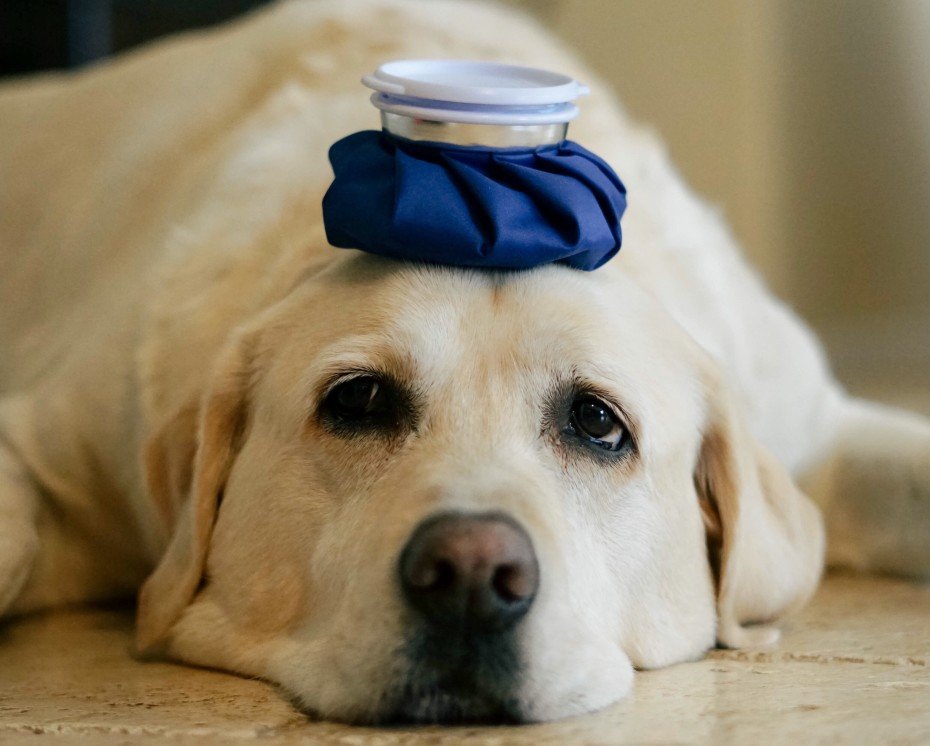Chocolate is extremely toxic to dogs, and depending on the type and quantity of chocolate eaten and the weight of your dog, it can cause a serious medical issue. If you know your dog has eaten chocolate, it is extremely important to monitor it for signs of toxicity, and it is recommended that you contact your vet for advice as soon as possible.

sickly dog – @Chantelle via Twenty20
In this article we look at how much chocolate would be too much for your dog, how not all chocolate is equal and the signs to look for in your dog
Why Is Chocolate Toxic to Dogs
Chocolate contains both theobromine and caffeine, both of which can speed the heart rate and stimulate the nervous system of dogs. Caffeine is a noted stimulant used in human foods, especially drinks
Theobromine – Theobromine is the primary alkaloid found in cocoa and chocolate. Cocoa powder can vary in the amount of theobromine, from 2% theobromine, up to higher levels around 10%. Cocoa butter only contains trace amounts of theobromine. There are usually higher concentrations in dark than in milk chocolate. Theobromine can also be found in trace amounts in the kola nut , the guarana berry, yerba mate (Ilex paraguariensis), Ilex vomitoria, Ilex guayusa, and the tea plant. 28 grams of milk chocolate contains approximately 60 milligrams of theobromine, while the same amount of dark chocolate contains about 200 milligrams. Cocoa beans naturally contain approximately 1% theobromine.
Chocolate derived from cocoa beans contains a small amount of caffeine. The weak stimulant effect of chocolate may be due to a combination of theobromine and theophylline, as well as caffeine. A typical 28-gram serving of a milk chocolate bar has about as much caffeine as a cup of decaffeinated coffee. By weight, dark chocolate has one to two times the amount of caffeine as coffee: 80–160 mg per 100 g. Higher percentages of cocoa such as 90% amount to 200 mg per 100 g approximately and thus, a 100-gram 85% cocoa chocolate bar contains about 195 mg caffeine.
The risk of your dog becoming sick from ingesting chocolate depends on the type and amount of chocolate consumed and the weight of the dog. The concentrations of these toxic substances vary among different types of chocolates.
Here are a few types of chocolate listed in order of theobromine content from highest to lowest
Cocoa powder
Semisweet chocolate
Dark chocolate
Milk chocolate
The mean theobromine concentrations in cocoa and carob products are as follows, this includes a few popular products that contain chocolate
Item – Mean theobromine content ratio (10−3)
Cocoa powder – 20.3
Cocoa beverages – 2.66
Chocolate toppings – 1.95
Chocolate bakery products – 1.47
Cocoa cereals – 0.695
Chocolate ice creams – 0.621
Chocolate milks – 0.226
Carob products – 0.000–0.504
It will take just one ounce per pound of body weight of your dog to poison it. One pound of milk chocolate is poisonous enough for a 20 pound dog. While half pound of milk chocolate is enough for a 10 pound dog.
What are the Signs of Chocolate Poisoning?
The signs of chocolate poisoning will normally appear between 6 to 12 hours after your dog has eaten it, the symptoms may last up to 72 hours, here are a lat of symptoms to keep an eye out for.
Restlessness
Increased rate of breathing
Increased heart rate
Frequent urination
Vomiting
Diarrhoea
Seizures
What Should You Do If Your Dog Ate Chocolate
If you believe your dog ate chocolate, call your vet immediately. Based on your dog’s size and the amount and type of chocolate consumed, your vet may recommend that you monitor your dog for the clinical signs listed above and call back if his condition worsens.
In other cases, the vet may want you to bring your dog to the clinic. If your pet ate the chocolate less than two hours ago, your vet may induce vomiting and give him doses of activated charcoal, this works to move the toxins out of the body without being absorbed into the bloodstream. In severe cases veterinary intervention may be needed to provide other treatments which may include medications or IV fluids, these are designed to resolve the effects of the poisoning.
If your dog is suffering from seizures it may need to be monitored at the veterinary clinic overnight.
Preventative measures
The majority of these are common sense
Keep all chocolate away from your dog, keep it in a high place or a cupboard with a door on it.
No matter how tempted you may be to feed your dog chocolate (no matter how cute they look) do not do it.
If you drop chocolate on the floor pick it up as soon as possible.
If you have kids advise them not to feed the dog chocolate and tell them why. Kids do have a habit of feeding a dog anything they feel it would like to eat.
Train your dog to “leave it” – if you are on a walk then if someone has dropped chocolate , you can instruct your dog to “leave it” and they will hopefully they will ignore it



